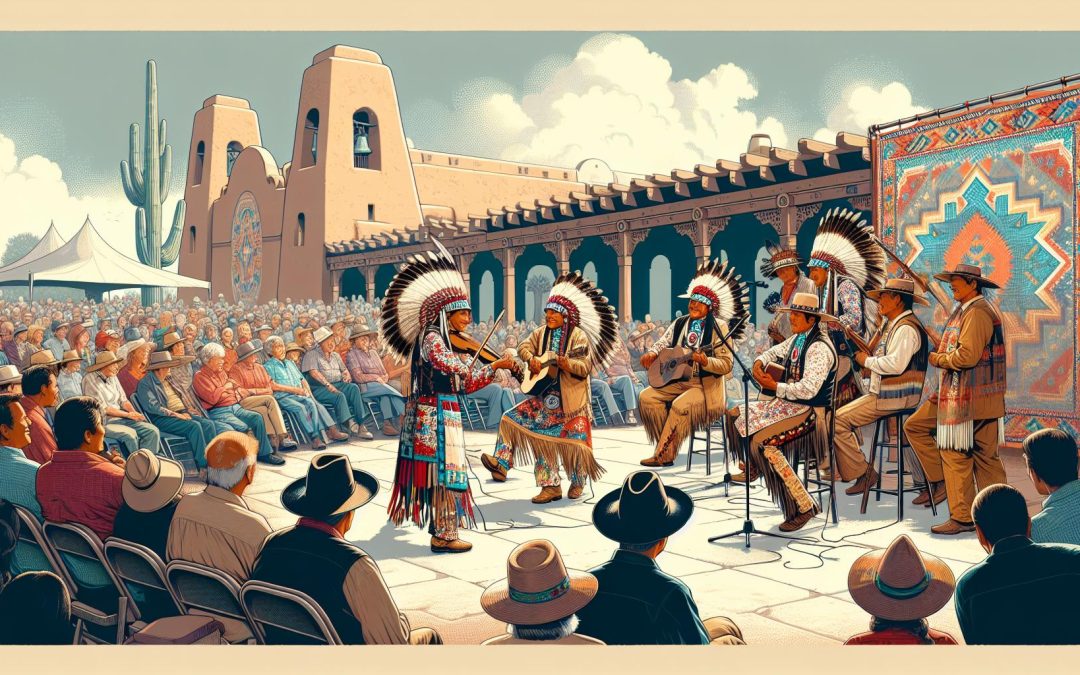Scottsdale, Arizona, isn’t just about upscale shopping and desert golf courses; it’s a gateway to a rich tapestry of Native American heritage. I’ve always been fascinated by the deep history and vibrant cultures that thrived long before Europeans set foot on the continent. So, I decided to dive into what Scottsdale has to offer for those of us eager to learn more about these ancient communities.
From the art galleries showcasing Native American crafts to historical sites that whisper tales of the past, Scottsdale is brimming with opportunities to connect with the traditions and stories of its original inhabitants. I’ll take you on a journey through the heart of the city, where the spirit of the Native American communities is alive and well. Join me as we explore the heritage that makes Scottsdale truly unique.
Indigenous Tribes of Scottsdale
As I dived deeper into Scottsdale’s roots, I discovered that this land is rich with the presence of Indigenous tribes, each with its unique culture and history. The most prominent among these are the Pima and the Maricopa tribes, who’ve inhabited this region for centuries. Their contribution to the area’s heritage is undeniable, offering a window into the past that’s both educational and fascinating.
The Pima, known to themselves as the “Akimel O’odham,” which means River People, have a deeply ingrained connection to the waterways of the Sonoran Desert. This connection has shaped their culture, traditions, and agricultural practices, revealing an incredible adaptation to the challenging desert environment. On the other hand, the Maricopa or the “Piipaash,” have their history interwoven with both the land and their neighboring tribes, showcasing a story of resilience, migration, and unity.
My journey into understanding the Indigenous presence in Scottsdale illuminated two critical aspects of these tribes:
- Their relationship with the land: It’s fascinating to see how their traditional knowledge and practices have allowed them to thrive in such a demanding landscape.
- Their art and craftsmanship: Visiting local museums and cultural centers, I was struck by the intricate basketry, pottery, and jewelry, which are not just art forms but also carry significant cultural narratives and values.
These insights have not only expanded my perspective but also deepened my appreciation for Scottsdale’s complex tapestry of histories. As I walked through the city, I couldn’t help but feel a profound respect for the Indigenous peoples who have shaped and preserved this land through generations.
Native American Cultural Centers in Scottsdale

During my journey through Scottsdale, I’ve had the pleasure of visiting several Native American Cultural Centers, each offering a unique perspective into the rich histories and vibrant cultures of the Native American communities in the area. These centers not only serve as educational resources but also as hubs for the preservation and celebration of Native American heritage.
One of the highlights was my visit to the Hoo-hoogam Ki Museum. Nestled on the Salt River Pima-Maricopa Indian Community, this museum captivated me with its extensive collection of artifacts, traditional crafts, and photographs. Walking through the exhibit halls, I felt as if I were stepping through time, witnessing the evolution of the Pima and Maricopa tribes firsthand. From intricate basketry to ceremonial attire, each piece told a story of survival, adaptation, and pride.
Another stop on my cultural exploration was the Scottsdale’s Native Art Market. Although not a cultural center in the traditional sense, this market is an explosion of colors, textures, and stories. Here, local Native American artists gather to showcase their work, ranging from pottery and jewelry to contemporary art pieces. Chatting with the artists, I learned about the symbols woven into their works and the stories behind their creations. This market is a testament to the thriving, dynamic nature of Native American art today, bridging the gap between tradition and modernity.
Through these visits, I’ve come to understand the importance of cultural centers and markets in keeping the spirit of Native American heritage alive in Scottsdale. They’re not just places to observe and learn but are active participants in the preservation of history, art, and tradition.
Exploration into Native American heritage in Scottsdale doesn’t end at museums and markets. The surrounding landscapes, filled with the echoes of ancient tales, invite further discovery. Each site, each piece of art, carries with it the essence of the many generations who have called this land home.
Exploring Petroglyph Sites
When I ventured into the heart of Scottsdale’s desert landscapes, I found myself engrained in an entirely different aspect of Native American heritage – their ancient petroglyph sites. These aren’t just ordinary rocks; they’re canvases that carry the tales of a civilization long gone yet still profoundly present. Petroglyphs, or rock engravings, offer a unique glimpse into the daily lives, beliefs, and histories of the Native American tribes that once flourished in the area.
One of the most captivating sites I discovered was the Hohokam Petroglyphs in the South Mountain Park. This sprawling park is home to thousands of these ancient artworks, some of which date back over 1,500 years. Wandering through the park, I couldn’t help but feel a deep connection to the past as I stood before these intricate designs of animals, humans, and geometric patterns, all etched into the desert varnish of the boulders and cliff faces.
Here’s a quick glance at the diversity of petroglyphs found across Scottsdale’s sites:
| Petroglyph Themes | Locations | Estimated Age |
|---|---|---|
| Animals | Hohokam Petroglyphs, South Mountain Park | Over 1,500 Years |
| Human Figures | Hohokam Petroglyphs, Spur Cross Ranch | 700-800 Years |
| Geometric Patterns | Hohokam Petroglyphs, Cave Creek | 900-1,000 Years |
Another significant site is the Spur Cross Ranch Conservation Area. This site is not only a breathtaking natural reserve but also a treasure trove of history. The petroglyphs here are more scattered, yet each one seemed to tell a story that’s part of a larger tapestry of Native American presence in the region.
Exploring these petroglyph sites has been an eye-opening journey into the artistry and spirituality of Scottsdale’s earliest inhabitants. I learned so much just by observing these silent storytellers. These engravings act as a bridge between the past and the present, reminding us of the rich cultural heritage that has shaped this land. They’re an essential part of understanding not just Native American history but also the broader narrative of human connection to nature and art.
Traditional Native American Cuisine in Scottsdale
Continuing my journey through Scottsdale’s rich Native American heritage, I couldn’t pass up the opportunity to dive into the traditional cuisine. It’s one thing to see and touch the history, but tasting it? That’s an entirely different immersion.
I started at a local eatery renowned for its Traditional Native American dishes. The first bite of blue corn mush, a staple in the diet of many Native American tribes, transported me back in time. It’s amazing how something as simple as corn can be transformed into a dish so rich in flavor and history.
Next on my culinary adventure was the Navajo taco. Originating from the Southwest, this dish is a testament to the blend of Native American and Hispanic cultures. Sitting on a fluffy frybread, instead of a tortilla, topped with beans, lettuce, cheese, and tomato, this taco is a taste sensation. It’s fascinating how the ingredients reflect the agricultural practices and the mingling of cultures over centuries.
For those interested in trying these dishes, here are some spots in Scottsdale that offer an authentic taste of Native cuisine:
- The Fry Bread House: Award-winning and family-owned, this spot specializes in fry bread in its many forms, both savory and sweet.
- Kai Restaurant: For a more upscale experience, Kai Restaurant offers a fusion of Native American cuisine with a modern twist.
Visiting these eateries not only satiated my hunger but deepened my appreciation for Native American culture. The fusion of flavors, the history baked into each dish, and the stories told through food, added layers to my understanding of Scottsdale’s rich heritage. Food, in its essence, is a narrative, and every bite I took felt like a page turned in the vast, unfolding story of this land.
Preserving and Celebrating Native American Heritage

As I continued my journey through Scottsdale, it became apparent that the preservation and celebration of Native American heritage is no small feat. It’s a multifaceted endeavor that spans various aspects of culture, from art to architecture, and of course, culinary traditions. The locals, many of whom are descendants of the original Native American tribes, take immense pride in maintaining the integrity and spirit of their ancestors’ traditions.
One of the most impactful ways Scottsdale honors this heritage is through its vibrant art scene. Galleries and museums across the city showcase an incredible array of Native American art, including pottery, jewelry, textiles, and paintings. One standout experience for me was visiting the Scottsdale Museum of Contemporary Art, where the Native Art Now! exhibit left me awe-struck. The exhibit features contemporary pieces that push the boundaries of traditional Native American art, proving that while the community respects its roots, it’s also not afraid to innovate and evolve.
Community events also play a crucial role in keeping the heritage alive. Festivals such as the Scottsdale Native Trails festival, which I had the pleasure of attending, offer a mesmerizing blend of music, dance, and storytelling. These events are not just entertaining; they’re educational, providing deep insights into the rich tapestry of Native American culture that’s woven into the fabric of Arizona.
Another aspect I admired was how Scottsdale’s architecture reflects Native American influences, with many buildings incorporating elements like natural materials and colors that echo the surrounding desert landscape. This architectural homage creates a sense of place and continuity, reminding visitors and residents alike of the land’s original stewards.
Through these experiences, it was clear to me that Scottsdale doesn’t just preserve Native American heritage; it celebrates it with every opportunity. The dedication to showcasing and honoring this culture offers a deeply enriching experience for anyone looking to explore and understand the pivotal role Native Americans play in the identity of the region.
Conclusion
Scottsdale’s journey through Native American heritage has truly been an eye-opener for me. It’s more than just a trip down history lane; it’s a living, breathing celebration of a culture that’s both ancient and ever-evolving. From the art that speaks volumes to the architecture that whispers tales of yore and the culinary delights that bring a taste of tradition, I’ve come to appreciate the depth and richness of Native American influence in this region. My experience here has been nothing short of enlightening, offering me a glimpse into the soul of a community that thrives on remembering and honoring its roots. If you’re ever in Scottsdale, I urge you to dive into this cultural mosaic and see for yourself the beauty and resilience of Native American heritage. It’s an experience that’ll stay with you long after you’ve left.







